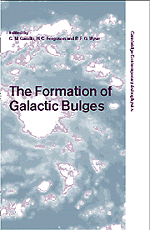Book contents
- Frontmatter
- Contents
- Preface
- Dedication: In Memory of Olin Eggen
- Part 1 Introduction
- Part 2 The Epoch of Bulge Formation
- Part 3 The Timescales of Bulge Formation
- Part 4 Physical Processes in Bulge Formation
- The Role of Bars for Secular Bulge Formation
- Bars and Boxy/Peanut-Shaped Bulges: An Observational Point of View
- Boxy- and Peanut-Shaped Bulges
- A New Class of Bulges
- The Role of Secondary Bars in Bulge Formation
- Radial Transport of Molecular Gas to the Nuclei of Spiral Galaxies
- Dynamical Evolution of Bulge Shapes
- Two-Component Stellar Systems: Phase-Space Constraints
- Central NGC 2146 – A Firehose-Type Bending Instability?
- Bulge Formation: The Role of the Multi-Phase ISM
- Global Evolution of a Self-Gravitating Multi-Phase ISM in the Central Kpc Region of Galaxies
- Part 5 Bulge Phenomenology
- Part 6 Conference Summary
- Index
A New Class of Bulges
from Part 4 - Physical Processes in Bulge Formation
Published online by Cambridge University Press: 10 November 2010
- Frontmatter
- Contents
- Preface
- Dedication: In Memory of Olin Eggen
- Part 1 Introduction
- Part 2 The Epoch of Bulge Formation
- Part 3 The Timescales of Bulge Formation
- Part 4 Physical Processes in Bulge Formation
- The Role of Bars for Secular Bulge Formation
- Bars and Boxy/Peanut-Shaped Bulges: An Observational Point of View
- Boxy- and Peanut-Shaped Bulges
- A New Class of Bulges
- The Role of Secondary Bars in Bulge Formation
- Radial Transport of Molecular Gas to the Nuclei of Spiral Galaxies
- Dynamical Evolution of Bulge Shapes
- Two-Component Stellar Systems: Phase-Space Constraints
- Central NGC 2146 – A Firehose-Type Bending Instability?
- Bulge Formation: The Role of the Multi-Phase ISM
- Global Evolution of a Self-Gravitating Multi-Phase ISM in the Central Kpc Region of Galaxies
- Part 5 Bulge Phenomenology
- Part 6 Conference Summary
- Index
Summary
Inspecting a sample of edge-on galaxies selected from the RC3 (de Vaucouleurs et al. 1991) with D25 >2arcmin (∼1350 galaxies) on the ‘Digital Sky Survey’ we have identified a class of approximately 20 disk galaxies with prominent, large, and boxy bulges. These bulges all show irregularities and asymmetries which are suggestive of them being formed just recently and not yet dynamically settled. We will present some examples and first results from CCD follow-up observations.
While the large frequency of boxy- or peanut-shaped bulges in disk galaxies (nearly 50%) is best explained by the response of the stellar disk to a bar potential, we propose soft-merging of companions as the most likely scenario for the evolution of this new class of thick boxy bulges.
Introduction
Statistics of boxy- and peanut-shaped (b/p) bulges in edge-on galaxies show (Shaw 1987, Dettmar 1989) that such bulges are not really that peculiar as it seemed in the past and very common processes are required to explain the high frequency. At present several mechanisms for their origin are discussed. Binney & Petrou (1985) and Whitmore & Bell in their paper on IC 4767 (1988) suggested that these structures may result from material accreted from infalling satellite companions (soft merging). An alternative mechanism for forming boxy bulges are instabilities or resonances animated by bars (Combes et al. 1990; Raha et al. 1991). N-body simulations for stars in barred potentials have demonstrated that with regard to the shape of bulges this theory and observational evidence are consistent.
- Type
- Chapter
- Information
- The Formation of Galactic Bulges , pp. 124 - 127Publisher: Cambridge University PressPrint publication year: 2000



